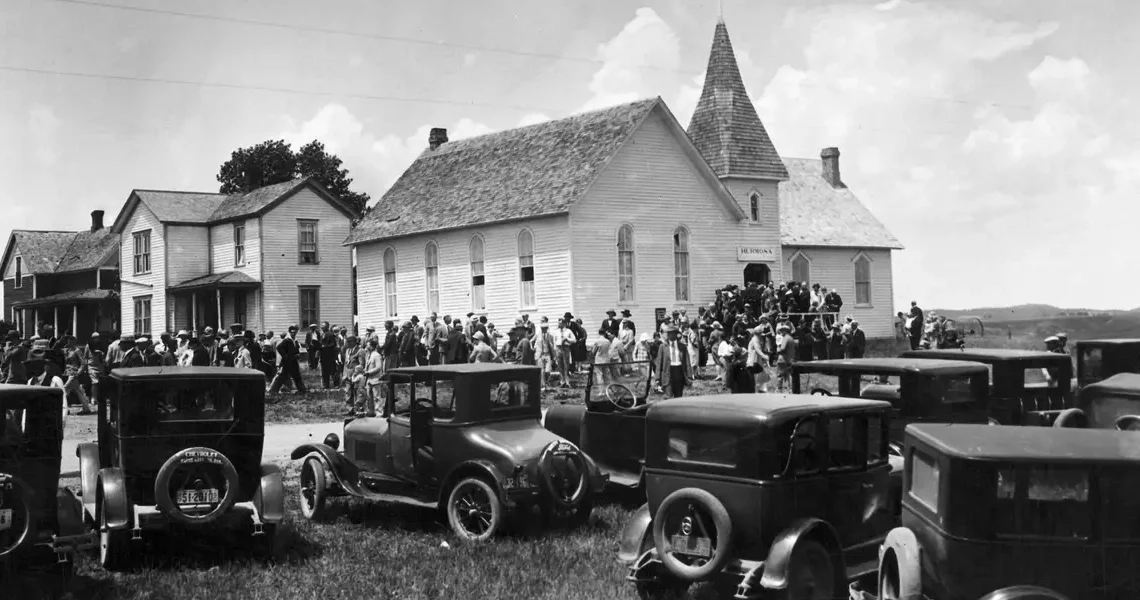Rural small towns today might be shaped by Dollar General stores and rusty industrial plants, but many across the US were once lively brick-paved main streets where domestic manufacturing and tight-knit communities flourished.
Some of America’s small towns have grown in recent years, with young people moving in, while others that prospered a century ago now lie abandoned.
By the mid-century, declining industries began shaping what is now known as the Rust Belt, where once-booming iron, steel, and automobile plants were abandoned as manufacturing industries moved overseas.
But before the economic turmoil, small towns across the US were home to close communities, quaint main streets, and the first automobiles.
In some villages and small towns, like Normal, Nebraska, the bank was a building smaller than a house. In Hugo, Oregon, the high school was the size of a midsize church.
Take a look at what small towns looked like 100 years ago.
Oatman, Arizona, started as a mining town after gold was found nearby in the early 1900s.
Between the early 1900s and the 1940s, Oatman and nearby Gold Road were Arizona’s biggest gold producers, and the town used to be a bustling center with over 10,000 inhabitants.
When 2020 census data was collected, it had a population of 102 people.
Today, the “lively ghost town” is defined by its streets of historic buildings, burros on the streets, and people wearing old-timey clothing and gunfighter costumes, as reported by Legends of America.
The main street in Manning, Iowa, was a dirt road until it was paved in 1915.
The town was founded in 1881 and was named for O.H. Manning, a politician.
The town of 1,500 is about 2 miles long and 2 miles wide, and its Main Street was paved in 1915, a community website reported.
In Eastman, Wisconsin, in 1920, the town’s power plant was a small building that looked like it could be someone’s home.
Eastman was established in 1855 and was named for Ben C. Eastman, a member of Congress from the district.
More recently, the town has a population of 350, according to 2020 census data.
The state bank in Normal, Nebraska, is pictured in the early 1900s.
The town was annexed in 1919 to become a part of the nearby city of Lincoln.
In 1927, all 84 residents of Hermosa, South Dakota gathered to meet President Coolidge.
In 1927, President Calvin Coolidge took a “working vacation” to South Dakota’s Black Hills to get a break from the hectic politics of Washington, DC, and win over rural populations, The Rapid City Journal reported.
The president’s visit was supported by the expansion of the air mail service, which helped communications from the small, remote town, Vermont Public reported.
A town baseball game can be seen in this image of Boothbay Harbor, Maine, in 1910.
The town of Boothbay Harbor was incorporated in 1889 and became a trading and shipbuilding center.
Today, the coastal town’s main industries are boat manufacturing, fishing, and tourism, according to the Boothbay Harbor Chamber of Commerce.
Pictured in Cordell, Oklahoma, in 1920, two people pose by a sign that discourages speeding.
The town was established on land taken from the Cheyenne and Arapaho people. According to the Oklahoma Historical Society, at the end of the 19th century, a general merchandise store with a post office was established nearby. The name of the town honors a postal employee, Wayne W. Cordell.
In the early 1900s, Manhattan, Nevada, attracted settlers after gold was found nearby.
In 1905, a prospector found gold, and within a year, its population had reached 4,000, Travel Nevada reported.
Today, about 125 people reside in the town, and residents often refer to their community as a “living ghost town,” per Nevada’s state tourism agency.
Bannack, Montana, also began as a mining town after gold was discovered in a nearby creek.
Although the town had enjoyed decades of prosperity due to the resources provided by Grasshopper Creek, by the 1930s, few residents remained.
In the following decade, the local school had to close down due to a lack of students, effectively turning the once-prosperous town into a ghost town. It is now part of a state park where dilapidated buildings are preserved.
Bonners Ferry, Idaho, pictured in 1926, was another bustling mining community.
Gold was discovered nearby in the mid-1800s.
Today, the town of 2,500 features a revitalized downtown area for tourists to visit, according to the town’s website.
In 1925, Dayton, Tennessee, became famous for the Scopes Trial.
In 1925, a Dayton high school science teacher, John T. Scopes, was tried and found guilty for teaching Charles Darwin’s theory of evolution in what became known as the Scopes Trial.
Hugo High School, pictured in 1926, taught students in Hugo, Oregon, for more than 50 years.
The discovery of gold in the county in the 1850s brought families to the area. The school opened in the 1890s and closed in 1967, according to its alumni Facebook page; this aligned with the trend of schools closing in rural towns in the mid-20th century, as populations moved to cities and amid school consolidations and reforms.
Fleischmanns, New York, was a vacation town for those looking to escape the New York City heat.
Farmers discovered they could make money from people leaving the city, and hotels and guest houses popped up throughout the town.
The town was home to 210 residents during the 2020 census.
Provincetown, Massachusetts, began as a fishing and whaling community.
In 1914, the Provincetown Art Association and Museum was founded by a group of prominent local artists. They worked with local businesses to create an art collection and educate the public in the arts.
The town is known for being the 1620 landing site of the Mayflower.
Lumber operations are pictured in Crossett, Arkansas, in the 1920s.
The town was named after Edward S. Crossett, a lumber entrepreneur.
Stillwater, Minnesota, was incorporated in 1854 and also began as a lumbering town.
The town “had all the ingredients for a lumbering town,” as reported by the Washington County Historical Society. The town features rivers connecting the small community to the pine forests of northern Minnesota and Wisconsin, and still waters that allowed for the raft assembly industry to flourish locally.
In 2011, Forbes named it as one of America’s prettiest towns.
Holy City, California, was established by a cult leader and white supremacist, William E. Riker, in 1919.
Holy City was created not as a religious oasis, as the name would indicate, but instead as “a commune and tourist trap created in the 1920s by a white-supremacist huckster,” the San Francisco Chronicle wrote.
The Chronicle also reported that Holy City was reduced to “a few derelict buildings” after facing fire, neglect, and a new freeway that cut off the compound from major roads.
Mercury News reported in 2016 that the town was purchased after a decade on the market by Robert and Trish Duggan, billionaire Scientologists.
Taos, New Mexico, was established as early as 1000 AD by the Taos Pueblo people.
Historians estimate that the ancestors of the Taos Pueblo people built their living structures, as well as pottery and ceremonial buildings, as far back as 1000 AD, according to Taos.org.
Wrangell, Alaska, pictured below in the early to mid-1900s, was discovered by the Tlingit tribe.
The Native Alaskan populations remained isolated until the early 1800s, per Wrangell’s website.
Lt. Dionysius Zarembo, a Russian-American ship commander, landed on present-day Wrangell in 1833. It is the only city in Alaska to be ruled by four nations and under three flags — Tlingit, Russia, England, and the United States — according to the town’s website.
South Pass City, Wyoming, was founded as a gold mining town. It was later abandoned.
Today, the town is a historic site tourists can visit and see over 20 original restored buildings, per Wyoming History.
Read the original article on Business Insider
The post Vintage photos show what life was like in America’s small towns a century ago appeared first on Business Insider.




